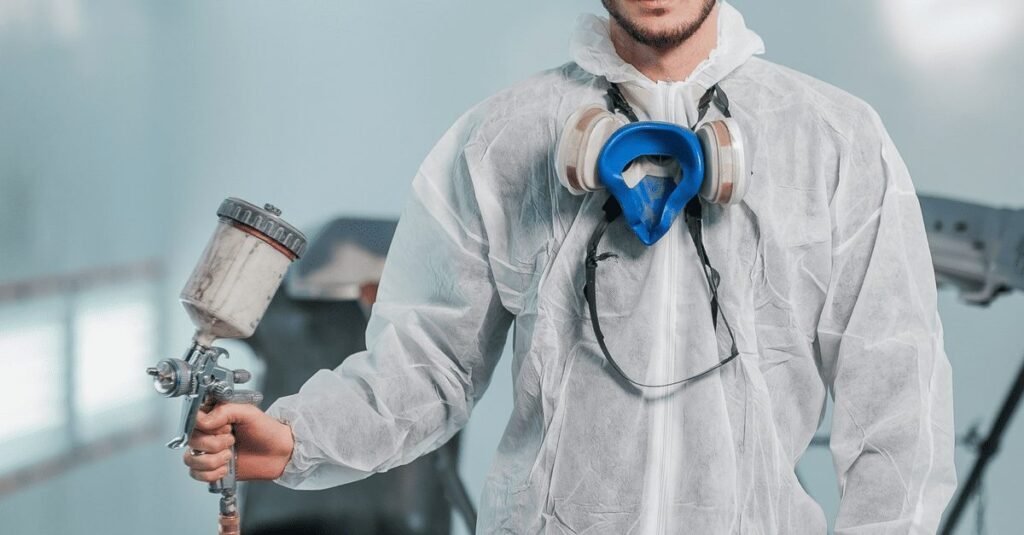PPE for Paint Spray: Ensuring Safety in the Workplace
Painting is a great way to make any object look good as new. But contrary to popular belief, it’s not just about spreading the paint on the surface. There’s quite a bit of preparation involved in painting, and one of the more important aspects of it all is safety. Among these safety measures are Personal Protective Equipment. In this article, we’ll talk about the importance of PPE when it comes to paint spraying and how it ensures safety in the workplace.

What is PPE for Paint Spray?
Personal Protective Equipment, or PPE, refers to the equipment and clothing designed to protect employees from various workplace hazards such as chemicals, radiation, and sharp objects, among others. PPE for paint spray specifically includes items that protect employees from the dangers of paint, solvents, and other chemicals used in the painting process.
PPE for paint spray commonly includes protective coveralls or lab coats, gloves, respirators, eyewear or safety glasses, and protection boots or shoes. The type of PPE required for paint spraying depends on the type of paint, the equipment used, and the workplace environment.
Why is PPE Important in Paint Spray?
The use of PPE during paint spraying is incredibly important. Paint contains chemicals that can be harmful when inhaled, ingested, or even absorbed through the skin. When in contact with the skin, it can cause irritation, rashes, or allergic reactions. Inhaling paint fumes can lead to respiratory problems, headaches, dizziness, and nausea. Some chemicals found in paint are even carcinogenic, meaning exposure can cause cancer.
Using PPE can prevent these hazardous effects. Coveralls or lab coats protect clothing from being contaminated, preventing harmful substances from being absorbed through the skin. Gloves prevent contact with chemicals that can cause skin irritation. Respirators and eyewear protect employees from inhaling fumes and particles that can cause respiratory problems and eye irritation.
While it may seem daunting to have to wear all these articles of protective clothing, the use of PPE ensures the safety of employees. By wearing PPE, employees can work more confidently and without the fear of exposure to hazardous substances.
What Should You Look for in PPE for Paint Spray?
When looking for PPE for paint spray, there are a few things to consider. First, ensure that the PPE is suitable for the type of paint being used and the equipment being operated. Protective clothing should be made of materials that are resistant to the chemicals of the paint and solvents, while eyewear should be durable and scratch-resistant.
The fit is also an important consideration when choosing PPE. Protective clothing should fit well, not too loose nor too tight. Gloves should have a snug and comfortable fit, while respirators should fit snugly around the nose and mouth.
It’s important to remember that some PPE may require special training to use effectively. Eyewear and respirators, for example, should be fitted by an experienced professional before use.
Making Sure PPE for Paint Spray is Properly Maintained
It’s not enough to just use PPE for paint spray safely. Proper maintenance of PPE is essential for ensuring that it holds up well and continues to provide reliable protection.
Equipment such as respirators and eyewear should be regularly cleaned and sanitized. Protective clothing should be checked for any signs of damage, such as rips or tears, and should be laundered after each use.
Replacing PPE for paint spray may also be necessary. The lifespan of PPE can vary depending on usage and exposure to chemicals. Gloves, for example, may need to be replaced more frequently than respirators.
Making PPE for Paint Spray a Priority
The use of Personal Protective Equipment, or PPE, for paint spray is essential for ensuring the safety of employees. By using PPE properly and consistently, employers can prevent hazardous exposure to paint and chemicals used in the painting process.
When selecting PPE for paint spray, make sure it is appropriate for the type of paint being used and equipment being operated. Be mindful of fit and maintenance requirements. By prioritizing the use and maintenance of PPE, employers can create a safer and healthier workplace environment for their employees.


